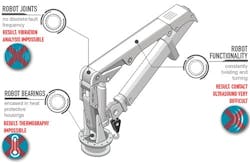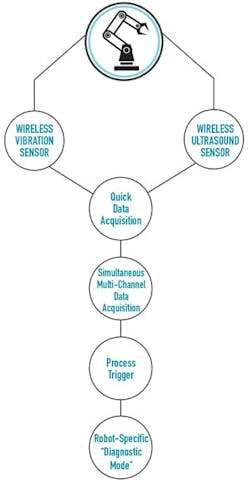High-tech solutions for high-tech assets
When the first robot was installed in a General Motors manufacturing facility in 1961, people held the belief that one day manufacturing or industrial robots would replace people in nearly every task associated with creating and assembling the products we use today.
Figure 1. The preventive maintenance you’ve been trying to complete will at best only resolve 3% of the failure modes associated with your robots.
Fifty years later, there are more than 2.4 million robots in use at manufacturing facilities around the world, and, while the robot has proven itself in terms of quality and efficiency, the high-tech solution comes with its own set of problems. Included with the technological advances comes a rather large set of random-based failure modes that can result in extended unplanned outages.
We recently worked with a group of robot experts to perform a reliability-centered maintenance (RCM) analysis of a manufacturing robot that had six rotating axes. In analyzing the equipment and controls, the team identified more than 250 failure modes, 97% of which were random-based (Figure 1). While an RCM purist might find some comfort in these numbers, the average maintenance and operations manager should pause and take note: The preventive maintenance you’ve been trying to complete will at best only resolve 3% of the failure modes associated with your robots.
Failure mode challenges in robots
If your company is at all like our client, which was wasting thousands of man-hours trying to complete preventive maintenance inspections that had grown over a period of time in an attempt to mitigate random-based failure modes that result from a lack of well-written job plans and precision maintenance techniques, then you may in fact be making matters worse by inducing infant mortality through human error. A robot is a high-tech asset; if you’re looking to mitigate some of the more significant random-based failure modes, you need to look for high-tech solutions.
Figure 2. Facilities have tried monitoring current and temperature as indicators of developing robotic developing, but those indicate failure modes and not early warnings.
While a large percentage of the robot’s failure modes are electronic in nature and can be greatly reduced by eliminating the enemies of electricity and a sound consequence reduction strategy, it’s the failures associated with the robot’s rotating components that result in extended periods of downtime with little more than a moment’s notice. One minute the robot is working fine, and the next it fails to return home or crashes and several hours later we discover that one of the gear reducers or bearings has failed.
In an attempt to apply a condition monitoring approach to the identification of issues within robot joints, facilities have tried to monitor items such as current and temperature as an indicator of trouble developing (Figure 2). The challenge here is that they’re looking at the result of the failure mode and not the early warning signals, which means they’re looking at the tail end of the failure curve. This is basically a watch-out warning and doesn’t allow ample time to plan, schedule, and correct with a proactive maintenance approach.
Condition monitoring challenges in robots
While those of us who specialize in the various disciplines of condition monitoring — vibration analysis, airborne ultrasound, lubrication analysis, and thermographic imaging, to name a few — have had tremendous success with detecting potential failures for rotating equipment, the robot has always created some unique challenges for the analyst.
Robot joints move slowly and rarely rotate a full 360°, making it impossible to assign discrete fault frequency content. Combine that with the safety issues of being anywhere near one as it operates, and it makes it difficult, if not impossible, to apply traditional vibration analysis techniques. The robot’s bearings and gears are encased in housings that sink heat away; combine that again with the fact that most robotic joints rotate slowly, and thermographic imaging is no longer a viable option. While contact ultrasound could be an option, the twisting and turning of the robot’s joints makes it difficult to apply long enough to get a useful sound signature that would indicate potential failures. Considering all of these issues, one might attempt to install a condition-monitoring technology permanently with the hope that a continuous signal might detect enough vibration, noise, or heat to indicate potential failures, but the twisting and turning of the robot’s various axes create a whole new set of challenges (Figure 3).
Figure 3. A continuous signal from a permanently installed condition-monitoring technology might detect enough vibration, noise, or heat to indicate potential failures, but the twisting and turning of the robot’s various axes create a whole new set of challenges.
Figure 4. Utilizing high-frequency domain data available with this monitoring solution allows for the earliest possible notification of issues developing, which will allow ample time for proactive initiatives.
High-tech assets require high-tech solutions
We permanently installed sensors in a way that allowed monitoring of the robot on a near continuous basis without interfering with the robot’s performance. The equipment has to work with a wireless transmitter to enable sending information from up to seven sensors on as many robots as the customer wants to analyze (Figure 4).
The result is a system that uses data from vibration monitoring and contact ultrasound and allows the setup of robot/joint-specific analysis parameters and alarm bands based on readings and emissions. Using a wireless vibration monitoring system enables quick data acquisition capabilities. Combine this simultaneous multichannel data acquisition with process triggers and robot-specific, diagnostic-mode operational programming, and you get consistent repeatable data for trending and analysis. Utilizing high-frequency domain data available with this monitoring solution allows for the earliest possible notification of issues developing, which will allow ample time for proactive initiatives. Data from early testing of the system on live robots indicates an on-line solution to detect nearly all of the failure modes associated with the rotating components of a robot.








